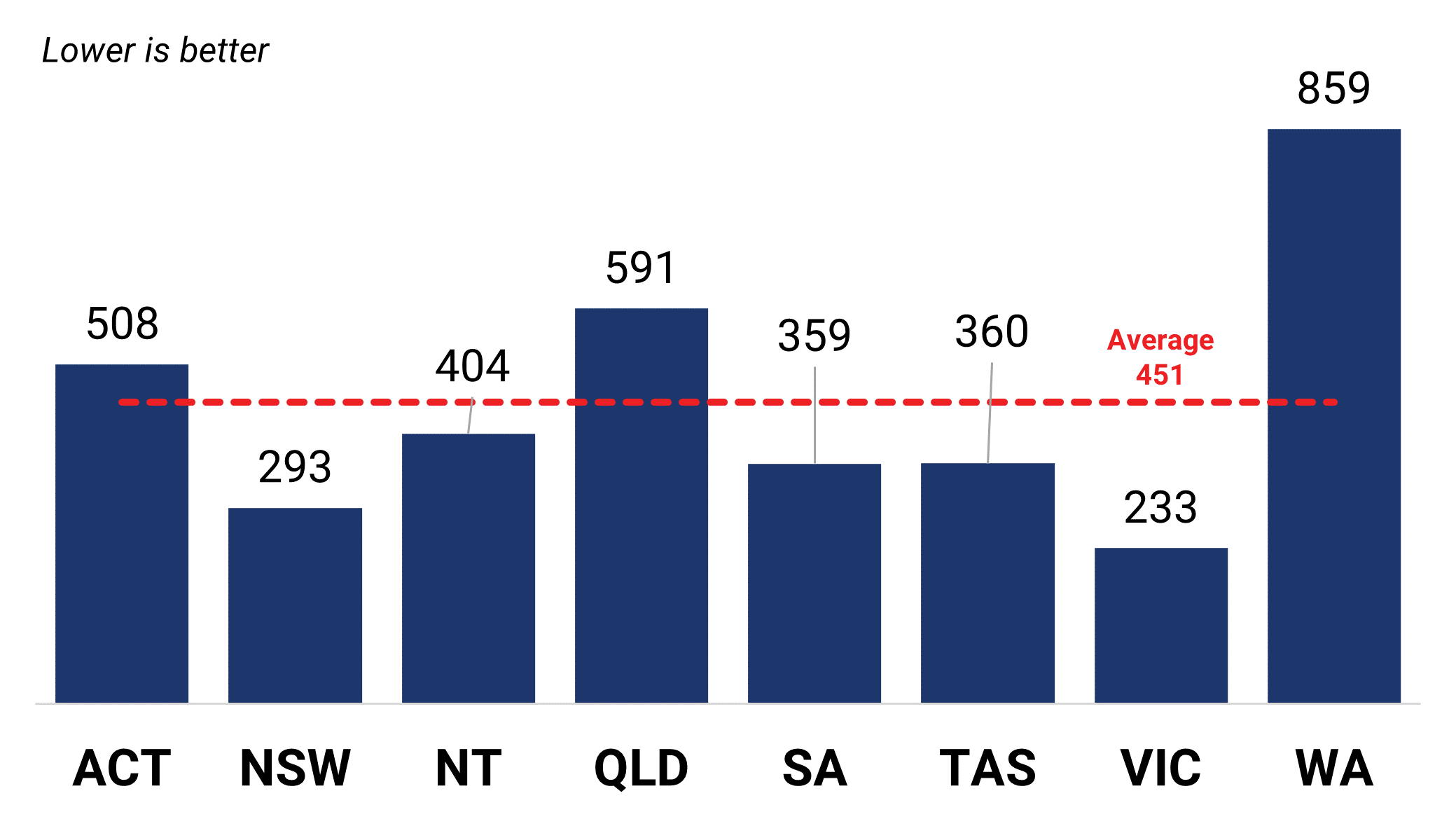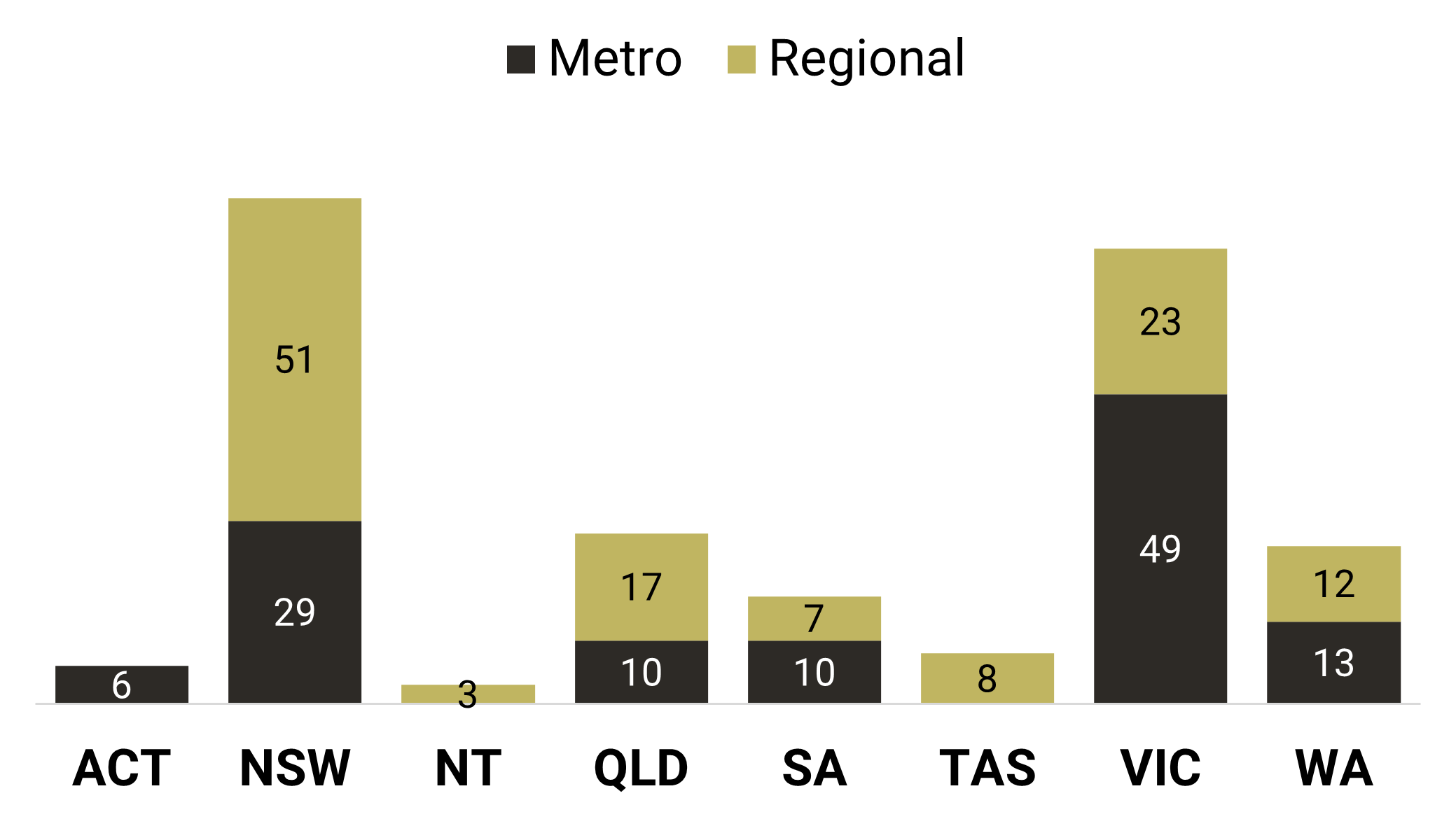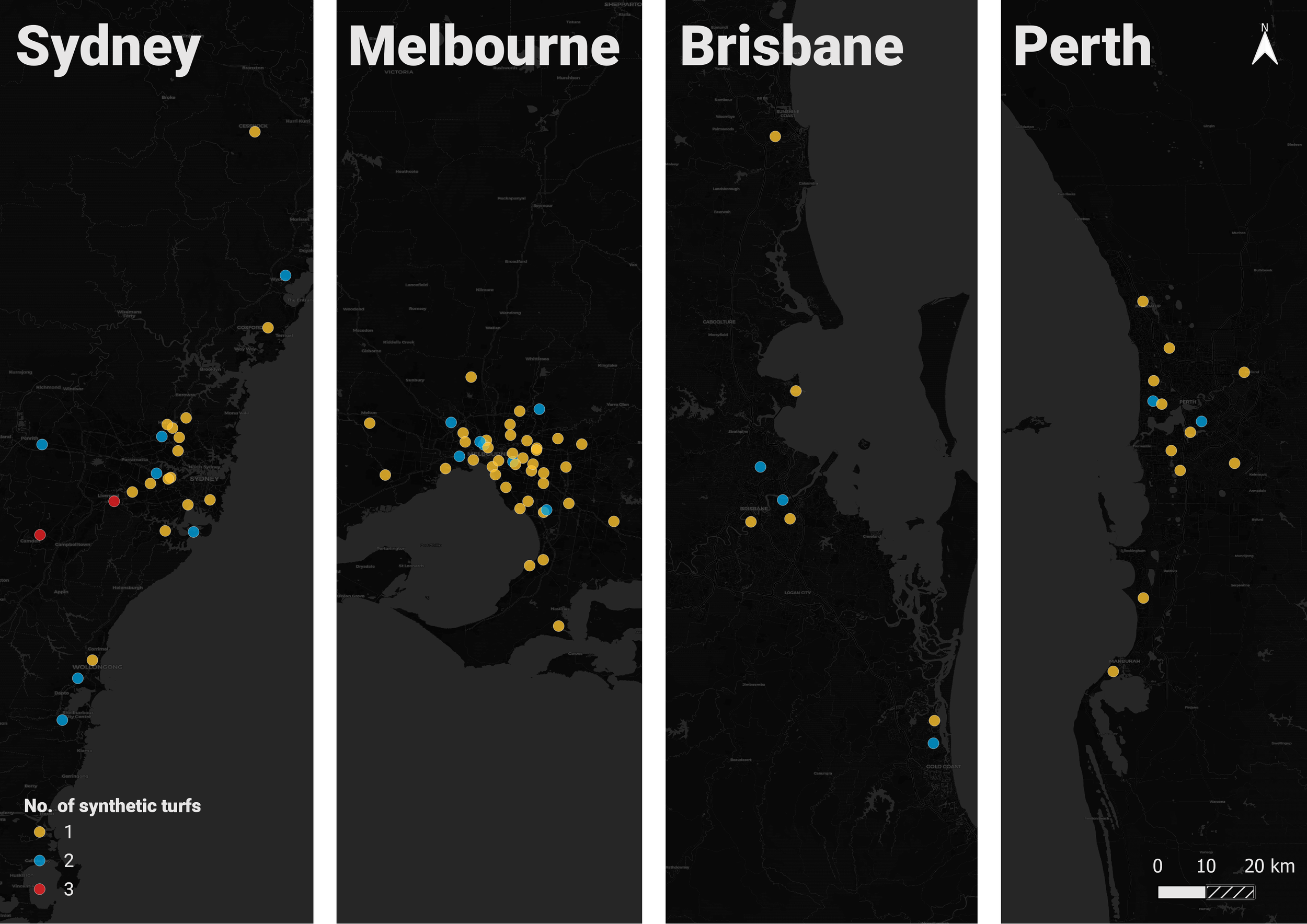Around the grounds
Synthetic turf fields are the foundational infrastructure of modern hockey. It was first used at a major field hockey tournament in the 1976 Olympics and rapidly became the standard surface for high-level hockey around the world. Synthetic turfs have made the game much faster and led players to develop new skills and techniques to take advantage of the surface.
Australia has excellent synthetic turf facilities. There are around 238 synthetic turf fields in Australia (see Figure 1). Synthetic turfs have been installed at many towns and suburbs including remote locations such as Alice Springs and Kalgoorlie. Most synthetic fields are in NSW (80) or Victoria (72) – the two most populous states in Australia. The next most populous states have less synthetic turf fields - Queensland (27), Western Australia (25) and South Australia (17), and the least populated states unsurprisingly have the least synthetic turfs – Tasmania (8), ACT (6) and Northern Territory (3).
Figure 1: Location of synthetic turfs in Australia
Source for maps: © OpenStreetMap contributors, © Carto.
Synthetic turf requirements
Hockey participation in Australia does not correlate with state populations. Western Australia and Queensland have relative more hockey members than Victoria. As such, to make the data comparable we have considered the number of Hockey Australia (HA) members per turf (i.e., take the number of hockey playing members in a state and divide it by the number of synthetic turfs) (see Figure 2).
Figure 2: HA members per turf by State or Territory
Generally, it is better (from a player perspective) to have a lower number of members per turf. For instance, consider a typical, busy suburban club. It might have four one-hour training slots per night on four days per week. If two teams train each session and each team uses half the field, (e.g., 15 player per half-field or 30 players per field) then approximately 120 players can train per night (i.e., 480 players per week). This might be an optimistic case – the club might want some teams to train more than once a week, or it might want to have training sessions that are 90 minutes long. These changes might reduce the maximum number of players that can train to around 300 per week. This example illustrates that when the number of players per turf increases beyond some optimal amount it could force:
densification (i.e., more teams or players per slot);
extended hours (i.e., teams training during work hours or late into the evening); or
reduced pitch times (i.e., teams train less often or for a shorter duration than is desired).
Victoria has the lowest number of members per turf (233) and Western Australia has the highest number of members per turf (859). That said, the metric does not tell the full story. There are three different types of synthetic turf field:
Water-based
Sand-dressed (or hybrid)
Sand-filled
The highest standards of hockey (e.g., international matches) require a water-based field. According to data from Hockey Victoria, many of the fields in Victoria appear to be either sand-dressed or sand-filled. This reflects a greater number of multi-sport synthetic turfs, which is partly driven by a Victorian government policy to install facilities at schools (e.g., Brunswick Secondary College). Most synthetic turfs in NSW are water-based and used exclusively by the field hockey community.
The data includes synthetic turfs at independent schools (e.g., Aquinas College). Sometimes these schools have hockey clubs that use the turf (e.g., Reds) and sometimes the school does not have any clubs that use the turf. This means our approach of using HA members might not be accurate as the school competitions do not require their players to be HA members. Ideally, non-HA members from the various private schools’ competitions should be added to the HA members to improve the metric.
Despite these limitations, the metric suggests that more synthetic turfs may be required in Queensland and Western Australia.
Synthetic turfs in metropolitan and regional areas
The split of synthetic turfs between metropolitan and regional areas is different between the states (see Figure 3). NSW has the most synthetic turfs in regional areas (50) - this is more than double the number of regional synthetic turfs in Victoria. Queensland, with 17 turfs, also has a relatively large number of synthetic turfs in regional areas.
Figure 3: Split of synthetic turfs across metropolitan and regional areas State or Territory
In metropolitan areas, the story is different. NSW has fewer synthetic turfs in Sydney (26) and Newcastle (3) combined than there are in Melbourne (49). Melbourne is exceptional among Australian cities for the quantity and density of synthetic turfs within the city (see Figure 4). The contrast with Sydney is stark. Sydney has 22 turfs spread across 14 venues with an additional four turfs located at independent schools. Brisbane, which includes the Gold Coast and the Sunshine Coast on the map, is notable for the relatively low number of synthetic turfs for hockey.
Figure 4: Location of synthetic turfs in Australia’s major cities
Source for maps: © OpenStreetMap contributors, © Carto.
The Heidelberg Institute for Geoinformation Technology (HeiGIT) provides the openrouteservice (ORS), which can be used to estimate travel times to different venues. We use the ORS to estimate 15- and 30-minute isochrones for hockey venues in Sydney (see Figure 5). There are several major parts of Sydney that are more than 15 minutes away from a hockey venue including Blacktown, Windsor, parts of Campbelltown, Manly and the Northern Beaches. Parts of the latter two areas – Manly and the Northern Beaches – are more than 30 minutes away from a synthetic turf.
Figure 5: Isochrones showing 15- and 30-minute travel zones to hockey venues in Sydney
Source for maps: © OpenStreetMap contributors
Source for isochrones: openrouteservice
There are synthetic turf fields being built at the Gables, which should reduce travel times to a hockey venue in the north-west of Sydney. However, aside from a half-field being built at Narrabeen, it does not appear likely that Manly and the Northern Beaches will have access to full field synthetic turf in the foreseeable future.





